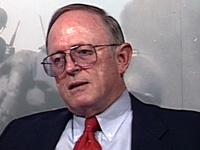| Leland Heywood Burgess, Jr. |

Leland Burgess [2004] | Vietnam War, 1961-1975; Persian Gulf War, 1991
Army; Army
Army Artillery, Army National Guard, Army Reserve
Fort Sill, Oklahoma; Fort Wolters, Texas; Fort Rucker, Alabama; Chattanooga, Tennessee; Vietnam
Colonel; Colonel
AL
 |
|
 |
Leland Burgess talks eloquently of the skill and accompanying arrogance helicopter
pilots possess. During his service in Vietnam he flew both reconnaissance and search and
destroy missions. After months of escaping enemy fire, his number came up in February
1968, when he discovered a bunker and attempted to fire on it. The return fire badly
injured his arm and his craft went down. Rescue was a while in coming, and Burgess and
his crew agreed they didn't want to be taken alive by the enemy. Burgess was in Vietnam
for the Tet Offensive, which he saw as a great victory for the U.S. and South Vietnam,
and he was disappointed to see how the ferocity of the offensive actually weakened support
for the war back home.
|
|

